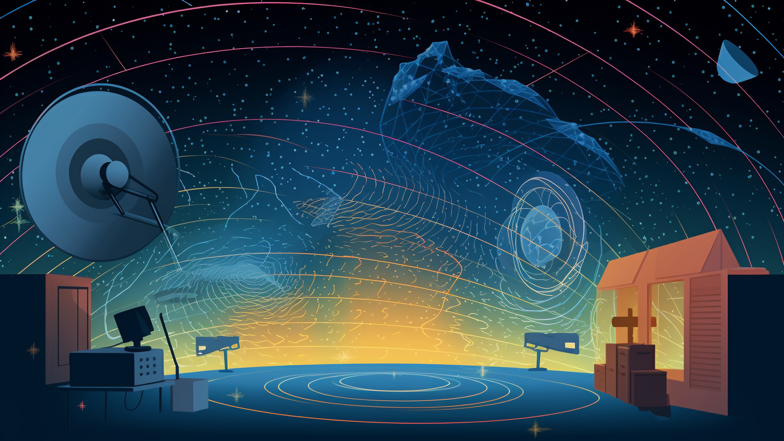The Revealing Secrets of Cosmic Microwave Background: Insights into the Universe's Origins and Evolution

The birth of the universe
To understand the importance of CMB radiation, we must first understand the origins of the universe. According to the Big Bang theory, the universe began as a singularity - a point of infinite density and temperature. This singularity then rapidly expanded in an event known as inflation, eventually leading to the formation of matter and the galaxies we observe today. In this early universe, electrons, protons and radiation were in thermal equilibrium, forming a sea of particles that emitted a uniform glow of thermal radiation.
As the universe expanded and cooled, this radiation began to lose energy and the universe became more transparent. After about 380,000 years, the temperature had fallen enough for electrons to combine with protons and form neutral hydrogen atoms. At this point, the universe became mostly transparent to radiation and the surface of last scattering was formed. This is the point at which the universe effectively became transparent to light and CMB radiation was emitted.
What is Cosmic Microwave Background radiation?
CMB radiation is the electromagnetic radiation left over from the Big Bang. It permeates the entire universe and can be observed in all directions, with a temperature of approximately 2.7 Kelvin (-270.45°C). This radiation is incredibly important to our understanding of the universe as it provides us with a snapshot of the universe at a time when it was only 380,000 years old.
The CMB radiation was first discovered in 1964 by Arno Penzias and Robert Wilson, who were attempting to map the radio emissions of our Milky Way galaxy. They found a constant level of radiation coming from all directions, which they initially thought was due to equipment problems. However, after consulting with cosmologists, they realized that what they had discovered was actually CMB radiation, providing pivotal evidence in support of the Big Bang theory.
The discovery of CMB radiation was one of the most significant scientific achievements of the 20th century. It provided concrete evidence for the Big Bang theory and supported the idea that the universe began as an infinitely dense, hot singularity. CMB radiation continues to be a focus of scientific research today, as it holds the potential to unlock some of the biggest mysteries of our universe.
The impact of CMB radiation on our understanding of the universe
CMB radiation has played a pivotal role in our understanding of the universe and has helped us answer some of the most fundamental questions we have about our existence. One of the most significant discoveries made using CMB radiation is related to the age of the universe.
Using the CMB radiation, scientists have been able to determine the age of the universe with remarkable accuracy. By analyzing the fluctuations in the temperature of CMB radiation, they have been able to determine that the universe is 13.8 billion years old, give or take 100 million years. This discovery was groundbreaking, as it allowed us to place the origins of the universe in context, and gave us a benchmark for the evolution of the universe.
Additionally, CMB radiation has led to groundbreaking discoveries surrounding the formation of galaxies and the nature of dark matter. It is believed that the seeds of cosmic structure were present in the CMB radiation, which allowed for the eventual formation of galaxies and other structures we observe in the universe today.
An interesting aspect of CMB radiation is the patterns of fluctuations observed in the temperature of the radiation. These patterns, which arise due to sound waves that propagate in the early universe, provide valuable insight into the composition of the universe and the nature of dark matter. Dark matter is a mysterious substance that makes up about 27% of the universe, but does not interact with light or other forms of electromagnetic radiation. By studying the temperature fluctuations in the CMB radiation, scientists have been able to determine that dark matter exists, and learn more about its properties.
CMB radiation has also been instrumental in our understanding of the expansion of the universe. It was discovered that the CMB radiation has a slight polarization, providing evidence for cosmic inflation - the rapid expansion of the universe that occurred after the Big Bang. This discovery provided new insights into the history and expansion of the universe, allowing for more accurate predictions and explanations of the universe's observed characteristics.
Looking to the future
As CMB radiation continues to be studied and analyzed, scientists hope to uncover even more insights into the origins and evolution of the universe. Future research will aim to provide a more detailed map of the temperature and polarization of CMB radiation, which will allow for even more accurate measurements of the universe's age, composition and rate of expansion.
There are also plans to develop new technologies and instruments that will be able to study CMB radiation with even greater precision. These instruments will be able to detect even the faintest fluctuations in the CMB radiation, providing us with more information about the early universe and the formation of galaxies.
Conclusion
In conclusion, CMB radiation is an incredibly important component of our universe that continues to provide valuable insights into the origins and evolution of the cosmos. The discovery of CMB radiation was a pivotal moment in the history of physics and astronomy, providing concrete evidence in support of the Big Bang theory.
Thanks to advances in technology and decades of research, we now have a wealth of information about the composition, age and structure of the universe. While there are still many unanswered questions, CMB radiation continues to be a valuable tool for scientists, helping us uncover the secrets of the universe and gain a deeper understanding of the cosmic story unfolding around us.
Comments
Post a Comment